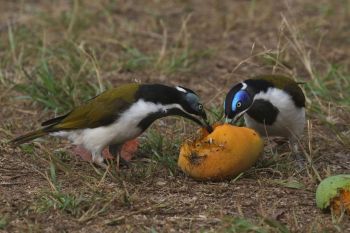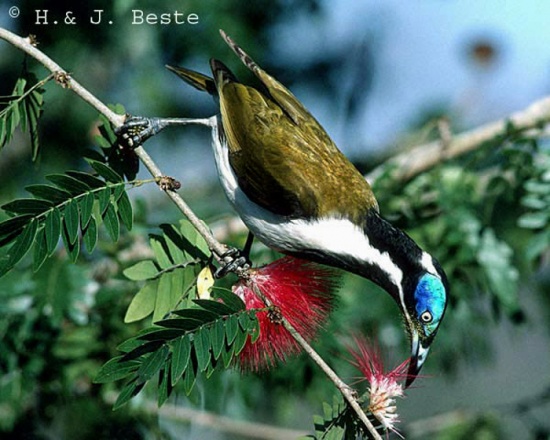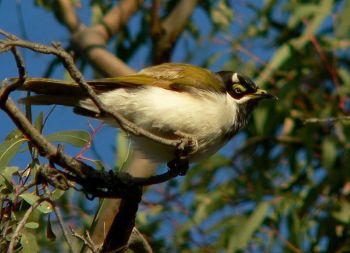- Entomyzon cyanotis
Identification

Female on left – Male on right
Photo © by Hans&Judy Beste
Blackbutt, Queensland, Australia, 21 February 2017
26–32·3 cm (10¼-12¾ in)
Adult
- White underparts
- Olive back and wings
- Bare blue skin around eye
- Blackish head and throat
- White stripe round nape
Juvenile
- Fledgling is 'red/brown' changing to bronze then yellow maturing through green and finally blue face patch.
Distribution
Southeast Asia and Australasia
South-east Asia: Indonesia
Australasia: Papua New Guinea, Australia, New South Wales, Northern Territory, Queensland, South Australia, Victoria, Western Australia.
Taxonomy
This is a polytypic species[1] consisting of 4 subspecies.
Subspecies
- E. c. albipennis:
- Northern Australia (Kimberley, Western Australia to north-western Queensland)
- E. c. harterti:
- Southern New Guinea (Trans-Fly lowlands)
- E. c. griseigularis:
- Northern Queensland (Cape York Peninsula)
- E. c. cyanotis:
- Eastern Australia (east and central Queensland to Victoria and south-eastern South Australia)
Habitat
It is found in tropical, sub-tropical and wetter temperate or semi-arid zones, mostly in open forests and woodlands close to water, mangroves and coastal heathland, wallum areas. Open scrub and suburban gardens.
Behaviour
The greet each other by lowering the head and opening the mouth in a wide yawning gape.
Diet
The diet includes insects, pollen, fruit, (especially bananas or grapes) and nectar.
Breeding
It builds a bowl shaped nest from twigs and bark. The clutch consists of 2 buff-pink eggs, splotched with red-brown or purple. The nest is parasitised by the Asian Koel.
Sub-adults help feed the juveniles.
Vocalisation
Call: ki-owt.
References
- Clements, J. F., T. S. Schulenberg, M. J. Iliff, S. M. Billerman, T. A. Fredericks, J. A. Gerbracht, D. Lepage, B. L. Sullivan, and C. L. Wood. 2021. The eBird/Clements checklist of Birds of the World: v2021. Downloaded from https://www.birds.cornell.edu/clementschecklist/download/
- Lepage D. (2021) [Avibase - https://avibase.ca/3EB7F778 ]. Retrieved 10 November 2021
- Higgins, P. J., J. del Hoyo, N. Collar, L. Christidis, G. M. Kirwan, and H. Ford (2020). Blue-faced Honeyeater (Entomyzon cyanotis), version 1.0. In Birds of the World (S. M. Billerman, B. K. Keeney, P. G. Rodewald, and T. S. Schulenberg, Editors). Cornell Lab of Ornithology, Ithaca, NY, USA. https://doi.org/10.2173/bow.blfhon1.01
- Wikipedia
- BF Member observations
Recommended Citation
- BirdForum Opus contributors. (2025) Blue-faced Honeyeater. In: BirdForum, the forum for wild birds and birding. Retrieved 26 April 2025 from https://www.birdforum.net/opus/Blue-faced_Honeyeater
External Links
GSearch checked for 2020 platform.1







